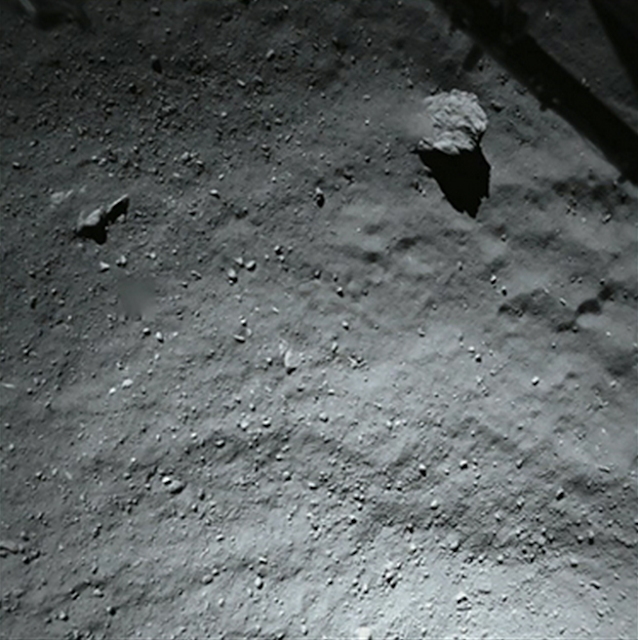ESA - Rosetta Mission patch.
November 13, 2014
Comet from 40 meters
Image above: This image was taken by Philae's down-looking descent ROLIS imager when it was about 40 m above the surface of Comet 67P/Churyumov-Gerasimenko. Image Credits: ESA/Rosetta/Philae/ROLIS/DLR.
It shows that the surface of the comet is covered by dust and debris ranging from mm to metre sizes.
The large block in the top right corner is 5 m in size. In the same corner the structure of the Philae landing gear is visible.
The aim of the ROLIS experiment is to study the texture and microstructure of the comet's surface. ROLIS (ROsetta Lander Imaging System) has been developed by the DLR Institute of Planetary Research, Berlin.
Welcome to a comet
Image above: Rosetta’s lander Philae is safely on the surface of Comet 67P/Churyumov-Gerasimenko, as these first two CIVA images confirm. One of the lander’s three feet can be seen in the foreground. The image is a two-image mosaic. The full panoramic from CIVA will be delivered in this afternoon’s press briefing at 13:00 GMT/14:00 CET. Image Credits: ESA/Rosetta/Philae/CIVA.
Image above: ESA scientists show the approximate location of the Philae lander on the Comet 67P/Churyumov-Gerasimenko comet after a bounce during landing on Nov. 13. Ulamec showed the approximate location on the comet (in blue) where Philae is believed to be. The initial landing area is illustrated in red. Image Credit: ESA TV.
The Philae lander would have bounced three times on the comet, its harpoons do not work properly. In addition, it seems that Philae is placed on a steep slope. This problem fixing the floor of the comet with harpoons could complicated drilling for soil samples.
It was decided to abandon the drill, too risky, the Philae lander may be propelled into space, given its delicate position balanced on two of the three legs. A temperature sensor will be deployed tonight.
Despite all of that, ESA scientists say they the lander is "working very well."
The first panoramic ‘postcard’ from the surface of a comet returned by Rosetta’s lander Philae
First comet panoramic
Image above: Rosetta’s lander Philae has returned the first panoramic image from the surface of a comet. The view, unprocessed, as it has been captured by the CIVA-P imaging system, shows a 360º view around the point of final touchdown. The three feet of Philae’s landing gear can be seen in some of the frames.
Confirmation of Philae’s touchdown on the surface of Comet 67P/Churyumov–Gerasimenko arrived on Earth at 16:03 GMT/17:03 CET on 12 November. Image Credits: ESA/Rosetta/Philae/CIVA.
Comet panoramic – lander orientation
Image above: Rosetta’s lander Philae has returned the first panoramic image from the surface of a comet. The view, unprocessed, as it has been captured by the CIVA-P imaging system, shows a 360º view around the point of final touchdown. The three feet of Philae’s landing gear can be seen in some of the frames.
Superimposed on top of the image is a sketch of the Philae lander in the configuration the lander team currently believe it is in.
Confirmation of Philae’s touchdown on the surface of Comet 67P/Churyumov–Gerasimenko arrived on Earth at 16:03 GMT/17:03 CET on 12 November. Image Credits: ESA/Rosetta/Philae/CIVA.
More about Rosetta:
Rosetta is an ESA mission with contributions from its Member States and NASA. Rosetta’s Philae lander is provided by a consortium led by DLR, MPS, CNES and ASI. Rosetta is the first mission in history to rendezvous with a comet. It is escorting the comet as they orbit the Sun together, and has deployed a lander to its surface.Comets are time capsules containing primitive material left over from the epoch when the Sun and its planets formed. By studying the gas, dust and structure of the nucleus and organic materials associated with the comet, via both remote and in situ observations, the Rosetta mission should become the key to unlocking the history and evolution of our Solar System.
Related links:
Rosetta overview: http://www.esa.int/Our_Activities/Space_Science/Rosetta_overview
Rosetta factsheet: http://www.esa.int/Our_Activities/Space_Science/Rosetta/Rosetta_factsheet
Frequently asked questions: http://www.esa.int/Our_Activities/Space_Science/Rosetta/Frequently_asked_questions
Rosetta Operations: http://www.esa.int/Our_Activities/Operations
Rosetta Blog: http://blogs.esa.int/rosetta/
Images (mentioned), Text, Credit: ESA / Orbiter.ch Aerospace.
Greetings, Orbiter.ch






